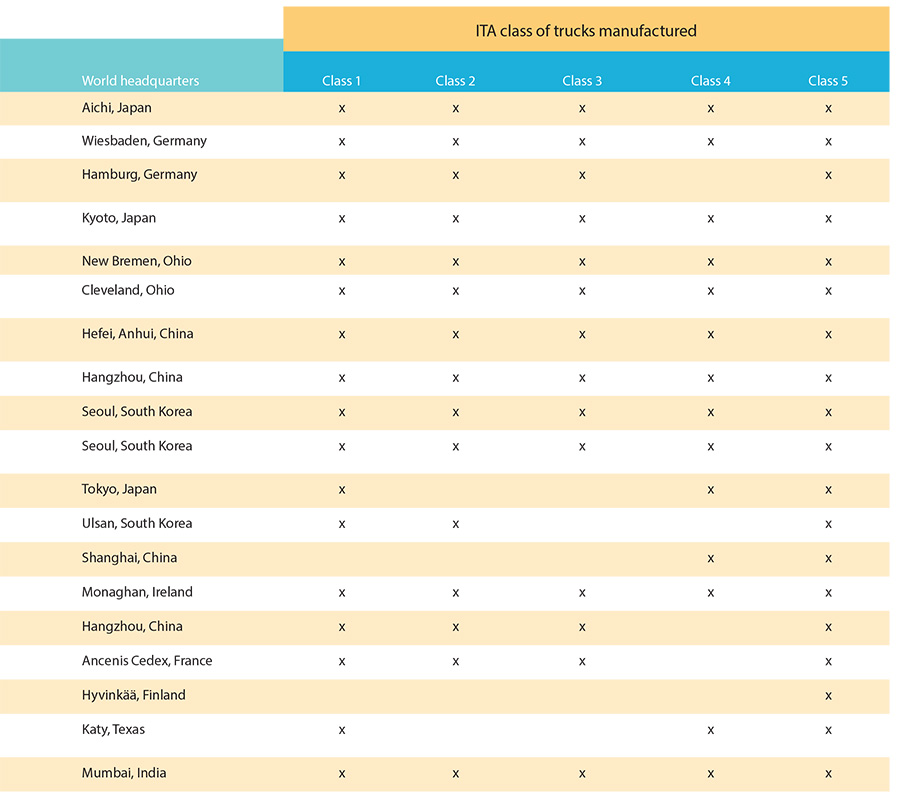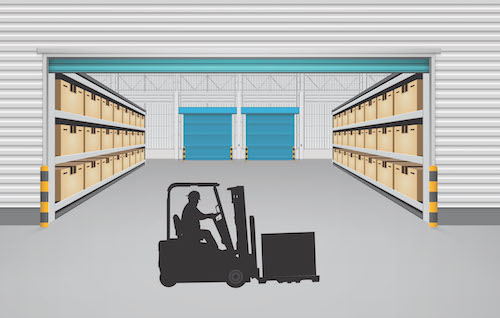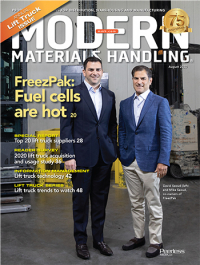Top 20 lift truck suppliers in 2020
The North American lift truck market was down slightly in 2019, but still saw some growth and ranked as the third-best year yet.
The North American lift truck market contracted slightly in 2019, following several consecutive record-setting years. With North American sales of 242,398 trucks down 6.8%, 2019 still ranks as the third-best year in the half century since the Industrial Truck Association (ITA) began keeping records. The combined revenues of the Top 20 grew 2.9% following years of double-digit growth.
“Going into 2020 we were cautiously optimistic,” says Jay Gusler, current chairman of the ITA and executive vice president of operations at Mitsubishi Logisnext America (formerly Mitsubishi Caterpillar Forklift America (MCFA)). “Another year like 2019 would have been great for our industry.”
The market was trending down even before mid-March, but Gusler says the first half of 2020 is only 10% off the same period in 2019.
Turbocharged trends
The pandemic has not been all bad for the industrial truck market. The electric forklift segment experienced a boom in demand, driven by big online retailers that are buying more Class 2 and 3 equipment, according to Gusler. So are companies deemed essential in the shutdown and are scrambling to expand operations to keep up with business.
Year-to-date, the ratio of electric to internal combustion units sold was 73:27, compared to 66:34 in 2019 and 64:36 in 2018. “In previous economic downturns we would see IC business decline more than electric,” Gusler says. “IC is common in construction as well as rental business, half of which are for events. In April, the tap got shut off for those kinds of rental demands.”
Gusler says the ITA worked to ensure the lift truck industry, from manufacturers to dealers to parts distributors, were on the essential business lists at the federal and state levels.
“As the essential business lists evolved, ITA worked hard to make sure the materials handling industry was included,” he says. “Everyone was thinking about the grocery, healthcare and medical supplies the country needed. Materials handling products are what moves all of those essential products around the country.”
Lift truck classes include:
- Class 1: electric motor trucks with cushion or pneumatic tires
- Class 2: electric motor narrow aisle trucks with solid tires
- Class 3: electric hand trucks or hand/rider trucks with solid tires
- Class 4: internal combustion engine sit down rider forklifts with cushion tires, suitable for indoor use on hard surfaces
- Class 5: internal combustion engine sit down rider forklifts with pneumatic tires, suitable for outdoor use on rough surfaces
- Class 6: electric or internal combustion engine powered, rider units with the ability to tow (rather than lift) at least 1,000 pounds
- Class 7: almost exclusively powered by diesel engines with pneumatic tires, these units are suitable for rough terrain and used outdoors.
Since primarily classes one through five are used in materials handling applications inside the four walls, Modern has only specified those on our supplier tableL
Other trends look much the same as last year, says Gusler. More customers are requiring some kind of telematics solution tied into a fleet management system. “It’s becoming the standard that a large customer’s RFQ requires a telematics system, whereas in the past that trend was just starting to pop up,” Gusler says. “As the technology becomes more standardized and affordable, it will trickle down to medium-sized customers.”
Warehouse management system (WMS) integration is moving ahead as more users add forklift-mounted screens tied to the WMS. Alternative fuel options like lithium-ion and fuel cells seem to be ticking up, Gusler adds. Lithium will keep getting cheaper, he says, and be used more and more each year. Automation is also an emerging segment of the market, as more forklift manufacturers automate existing models or partner with automation companies to achieve autonomous or semi-autonomous functionality.
Safety remains top of mind. Gusler highlights the success of the ITA-organized National Forklift Safety Day, which seeks to reinforce the safety and operator training message year-round. This year, the event was held online, which enabled greater attendance than the usual ceremonies in Washington, D.C. ITA’s annual meeting in September will also be virtual.
The Top 10
Toyota held the No. 1 spot. While the company sold 282,000 units in 2019—which include the Toyota and Raymond brands—representing a 7% increase over 2018, revenues were flat following a 16% spike in 2018. Last year also marked the integration of Toyota Industrial Equipment Manufacturing (TIEM) and Toyota Material Handling USA (TMHU) into Toyota Material Handling (TMH).
In early 2019, Toyota acquired Hoist Liftruck (renamed Hoist Material Handling). Headquartered in East Chicago, Ind., with a 550,000-square-foot factory, Hoist has nearly 25 years of experience manufacturing heavy-duty cushion tire and pneumatic forklifts, reach stackers, container handlers and more, ranging in lift capacity from 7 to 57 tons.
In late 2019, the company introduced Toyota Industrial Energy Solutions, a suite including on-site consultation, environmental support, battery and alternative energy sources, chargers and accessories, and service and repair. This followed the launch of a new line of lithium-ion battery options and a 24/7 online parts store.
At No. 2, KION reported an 8.2% increase in worldwide revenue for industrial trucks, reporting $7.173 billion in its annual report, but a 2.1% decrease in worldwide units sold. The North American market was particularly hard hit with a 7.6% decrease to 266,800 units sold. That was down from 288,800 in 2018. KION’s Asia-Pacific business, on the other hand, showed a 3.9% increase in 2019.
In third place, Jungheinrich reported a 7% increase in revenues despite a similar decrease in incoming orders and units sold, which was down from 121,000 units in 2018 to 112,900 in 2019.
Europe accounted for 87% of revenue, driven by increases in Germany, Austria, Italy and the UK, despite uncertainties surrounding Brexit. New truck business was up 6% and the short-term rental and used equipment business remained unchanged. Revenue from after-sales services increased 8%, and the financial services business exceeded the previous year’s figure by 20%.
The company released several new products in 2019, including a new generation of EKS medium/high level orderpickers with a picking height of 46 feet and lifting speed of 1.6 feet per second. It also released a Cloud-based fleet management solution and a redesigned modular Web tool.
| 2019 Rank |
Company Name |
2018 Rank |
2018 Revenue |
2019 Revenue |
% Change 2018-2019 |
North American brands | World headquarters |
| 1 | Toyota Industries Corporation | 1 | 13292 | 13356 | 0.50% | Toyota, Raymond | Aichi, Japan |
| 2 | KION Group AG | 2 | 6633 | 7173 | 8.10% | Linde, STILL, Baoli | Wiesbaden, Germany |
| 3 | Jungheinrich AG | 3 | 4363 | 4576 | 4.90% | Sold in NA by Mitsubishi | Hamburg, Germany |
| 4 | Mitsubishi Logisnext Co., Ltd. | 4 | 4270 | 4152 | -2.80% | UniCarriers, Mitsubishi, CAT | Kyoto, Japan |
| 5 | Crown Equipment Corp. | 5 | 3480 | 3720 | 6.90% | Crown, Hamech | New Bremen, Ohio |
| 6 | Hyster-Yale Materials Handling, Inc. | 6 | 3174 | 3292 | 3.70% | Hyster, Yale, Nuvera, Bolzoni |
Cleveland, Ohio |
| 7 | Anhui Forklift Truck | 7 | 1414 | 1438 | 1.70% | Heli, CHL | Hefei, Anhui, China Group Co., Ltd. |
| 8 | Hangcha Group Co., Ltd. | 8 | 1229 | 1268 | 3.20% | HC, Hangcha | Hangzhou, China |
| 9 | Doosan Industrial Vehicle | 10 | 1121 | 1166 | 4.00% | Doosan | Seoul, South Korea |
| 10 | Clark Material Handling International, Inc. | 9 | 790 | 783 | -0.90% | Clark | Seoul, South Korea |
| 11 | Komatsu Ltd. | 11 | 649 | 649* | 0.00% | Komatsu | Tokyo, Japan |
| 12 | Hyundai Heavy Industries | 12 | 400 | 406 | 1.50% | Hyundai | Ulsan, South Korea |
| 13 | Lonking Forklift Co., Ltd. | 13 | 343 | 343* | 0.00% | Lonking | Shanghai, China |
| 14 | Combilift Ltd. | 15 | 293 | 335 | 14.30% | Combilift | Monaghan, Ireland |
| 15 | EP Equipment, Ltd. | 14 | 294 | 310 | 5.40% | Big Joe | Hangzhou, China |
| 16 | Manitou | 16 | 218 | 218* | 0.00% | Manitou | Ancenis Cedex, France |
| 17 | Konecranes | 17 | 185 | 185* | 0.00% | Konecranes | Hyvink, Finland |
| 18 | Liuzhou LiuGong Forklift Co.,Ltd | N/A | 89 | 94 | 5.60% | LiuGong | Katy, Texas |
| 19 | Godrej & Boyce Mfg. Co. Ltd. | 18 | 79 | 77 | -2.50% | Not available in North America |
Mumbai, India |
| 20 | Hubtex Maschinenbau GmbH & Co. KG | 19 | 72 | 72* | 0.00% | Hubtex | Fulda, Germany |
| TOTAL | 42388 | 43613 | 2.90% |
Jungheinrich also acquired ISI Automation, a turnkey automation solution specialist. The company’s products will expand Jungheinrich’s digitalization portfolio in the area between enterprise resource planning and the shop floor.
Jungheinrich and Triathlon launched a joint venture in the field of lithium-ion technology to form JT Energy Systems. A second joint venture with Fricke Group will support the international sale of spare parts, where the two companies see growth potential in the independent aftermarket and e-commerce channel.
Mitsubishi Logisnext retained fourth place after a slight dip in revenues a spokesperson attributed to an unfavorable currency exchange rate. The company sold 103,000 units in 2019, down from 116,000 the previous year.
Mitsubishi Logisnext Americas Inc. (MLA), the holding company for Mitsubishi Caterpillar Forklift America Inc. (MCFA), acquired Pon Material Handling NA, a U.S. materials handling equipment dealer operating as Equipment Depot. The acquisition adds full-service materials handling operations across nine states. MCFA now has 110 authorized dealers covering more than 730 locations across North, Central and South America.
Mitsubishi Logisnext represents Jungheinrich in North America, a market that now has access to several new and previously European models.

The company released a new Mitsubishi 4,500- to 6,500-pound capacity electric cushion tire forklift series, and both Cat and Mitsubishi 3,000- to 4,000-pound capacity electric cushion tire lift trucks. It expanded its full range of forklifts to include a new generation of automation capabilities, including two AGV solutions: an automatic guided electric tow tractor and an automatic guided medium-to-high-level stacker.
Crown Equipment remains in fifth place after reporting a 7% revenue increase to $3.72 billion.
Hyster Yale grew almost 4% to hold sixth place with $3.29 billion in revenues. The company sold 100,300 units in 2019, down from about 101,900 units in 2018.
Hyster-Yale’s new product programs include products covering internal combustion engine and electric trucks. This year it introduced a new range of counterbalanced trucks. Also introduced were a range of trucks manufactured by Hyster-Yale Maximal in China, which are being launched globally under the Hyster UT and Yale UX brands to serve lower-intensity customer applications. In 2019, a new end rider and a new automated reach truck were released in the North America market, and a range of new lower-cost Class 3 lift trucks, including walkie and stacker global products, were sold in certain markets.
In early 2020, Hyster-Yale launched a new 3- to 5-ton integrated lithium-ion engine lift truck for the Americas and Europe, the Middle East and African markets, and expects to launch a 7- to 9-ton version later in 2020. The company expects to launch a newer-model reach truck for the Americas market in 2020.
The Worldwide Industrial Truck Statistics (WITS) organization tracks quarterly and monthly statistics on lift truck sales and its report is compiled by six trade groups based in North America, Brazil, Japan, Korea, Europe and China.
According to the 2019 WITS figures, global orders decreased by 2% and world shipments increased by 0.3%.
Worldwide Lift Truck Market

In seventh place, Anhui’s revenues increased slightly following a more than 14% jump in unit sales to 152,380 units.
Eighth-place Hangcha grew revenues by 4.9% in local currency, which equates to a 3.2% increase in dollars to $1.27 billion. The company sold 139,436 units in 2019. In 2019, the company introduced nearly 200 models of more than 40 product series to new markets.
In 2019, Hangcha invested $150 million in asset acquisition and equity, including increased capital investment in Pengcheng New Energy to expand lithium battery capacity and acquisition of all the France equity of Hangzhou Manitou Machinery Equipment Co. Ninth on our list is Doosan, which grew revenues by 4% in 2019.
Rounding out the Top 10, Clark Material Handling reported virtually unchanged revenues to finish 2019 with $783 million.
Notable performances
No. 12 Hyundai sold 16,515 units in 2019, a decrease from 2018, but Hyundai Construction Equipment (HCE) also became the first Korean-based company to develop driverless autonomous forklift trucks. According to the company, the autonomous forklift can determine optimal routes and be remotely controlled using a routing control system it developed. It also has a vehicle control system featuring 2D safety laser scanners that can perceive vehicle surroundings, detect obstacles and prevent collisions.
Combilift climbed one spot to 14 after selling 6,400 units, a 13% increase from 2018, and earning $335 million in revenue. Combilift continues its policy of investing 7% of turnover back into R&D and innovation, according to a Combilift spokesperson, who says the company’s range of products has seen a significant increase in sales, particularly in the North American market where the warehousing sector has shown interest in Combilift’s Aisle-Master and high-capacity Powered Pallet Trucks (PPT). In 2019, it introduced the new Combi-CBE model, a compact, electric 8,000-pound capacity multi-directional forklift truck.
Newcomer LiuGong debuts on our list in 18th place with $94 million in revenue. The company sold 10,935 industrial vehicles worldwide in 2018, an increase of 18.1% compared to 2017, and went on to sell 12,262 in 2019, an increase of 12%. The company introduced a new generation of Class 5 pneumatic tire forklifts, as well as new generation Class 1 and Class 4 cushion tire forklifts designed for the American market.
India-based Godrej & Boyce, No. 19, sold 3,668 powered industrial trucks in 2019 and targeted the three-wheel electric forklift market with the launch of its Bravo line, which the company says could help it capture 20% of the Indian electric forklift market before the end of the next fiscal year. The product was designed and produced in India following 24 months of R&D.
How the suppliers are ranked
To be eligible for Modern’s annual Top 20 lift truck suppliers ranking, companies must manufacture and sell lift trucks in at least one of the Industrial Truck Association’s seven truck classes: electric motor rider; electric motor hand trucks; internal combustion engine; pneumatic tire; electric and internal combustion engine tow tractors; and rough terrain lift trucks.
Rankings are based on worldwide revenue from powered industrial trucks during each company’s most recent fiscal year. Revenue figures submitted in foreign currency are calculated using the Dec. 31, 2019 exchange rate.

Article Topics
Lift Trucks News & Resources
BSLBATT is looking for new distributors and resellers worldwide Hyster recognizes Dealers of Distinction for 2023 Carolina Handling names Joe Perkins as COO Toyota Material Handling North America appoints Mark Taggart as CFO Learn from lift truck service history Toyota Material Handling honors its top forklift dealers in North America Fleet Team expands with strategic acquisition of Forklift Training Systems More Lift TrucksLatest in Materials Handling
Geek+ and System Teknik deploy PopPick solution for pharmacy group Med24.dk Beckhoff USA opens new office in Austin, Texas Manhattan Associates selects TeamViewer as partner for warehouse vision picking ASME Foundation wins grant for technical workforce development The (Not So) Secret Weapons: How Key Cabinets and Asset Management Lockers Are Changing Supply Chain Operations MODEX C-Suite Interview with Harold Vanasse: The perfect blend of automation and sustainability Consultant and industry leader John M. Hill passes on at age 86 More Materials HandlingAbout the Author
Subscribe to Materials Handling Magazine

Find out what the world's most innovative companies are doing to improve productivity in their plants and distribution centers.
Start your FREE subscription today.
April 2024 Modern Materials Handling

Latest Resources












